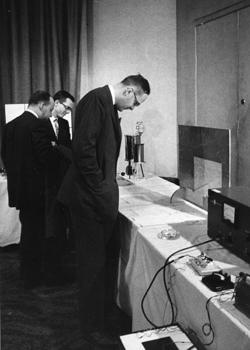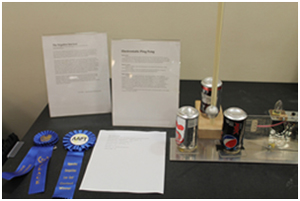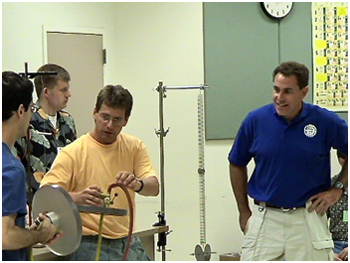History of AAPT — Laboratories and Lecture Demonstrations
Meanwhile a memorial of another kind was established to honor Lloyd W. Taylor of
Valuable committee reports and conference recommendations have appeared in AJP; lengthy items have appeared separately as occasional publications of the AAPT Executive Office. Among the significant AJP reports has been that of the Coulomb’s Law Committee, which appeared in January 1950. The Committee had been appointed in 1944 to examine the problems associated with fundamental concepts in electricity and magnetism, and its findings and recommendations were aimed toward eliminating textbook errors and encouraging clear and accurate formulations.

William C. Kelly inspects entry in the first Apparatus Competition in 1959.
Courtesy of the AIP Emilio Segrè Visual Archives
AAPT's Committee on Apparatus for Educational Institutions has a long history of contributions. Two of the early leaders were Sanborn C. Brown of MIT and William C. Kelly, then at the
 The Apparatus Committee arranged for the first Competition for New and Improved Apparatus to be held at the annual APS-AAPT meeting in 1959. Early competitions that followed were led by F.E. Christensen of St. Olaf College who arranged for subsequent descriptions of winning entries in AJP. Apparatus competitions were an important experimental physics feature of alternate annual meetings in subsequent years, while they are now typically held at each summer meeting.
The Apparatus Committee arranged for the first Competition for New and Improved Apparatus to be held at the annual APS-AAPT meeting in 1959. Early competitions that followed were led by F.E. Christensen of St. Olaf College who arranged for subsequent descriptions of winning entries in AJP. Apparatus competitions were an important experimental physics feature of alternate annual meetings in subsequent years, while they are now typically held at each summer meeting.
The pattern of award categories has varied: in the first competition there were two, demonstration apparatus and apparatus designed for student laboratories. In some years the prizes were given without designation of category. With increased participation by high school teachers, the most recent divisions have been based not according to the purpose of the apparatus, but on the institutional level of the person submitting the entry. The prize money has been contributed by one or more laboratory equipment companies. From 1983 to the present,
A very early reference source for demonstration lectures, also supported by NSF, was prepared by Harry F. Meiners of Rensselaer Polytechnic Institute (RPI), with Robert Resnick as co-chair of the AAPT Advisory Committee for the project. This very extensive and ambitious work was published by Ronald Press in 1970. It contained more than 2,000 photographs and line drawings, some 1,000 experiments in classical and modern physics, and essay articles on various aspects of physics demonstration experiments. In 1981 AAPT published the Demonstration Handbook for Physics by G.D. Freier and F.J. Anderson from the University of Minnesota. This was followed in 1982 by Wallace Hilton's Physics Demonstration Experiments at William Jewell College. Although Hilton's book went out of print in 1988, the Demonstration Handbook for Physics is still available. In 1987, a collection of articles on apparatus and ideas for teaching physics reprinted from The Physics Teacher was edited by Donna Berry and produced in the book A Potpourri of Physics Teaching Ideas. Also in 1987, a new physics demonstration experiments handbook was produced. This handbook, String and Sticky Tape Experiments, edited by Ronald Edge, has been a popular AAPT catalog item.
 The Apparatus Committee has also sponsored the AAPT's longest running (several decades) summer meeting workshop on lecture demonstrations. This popular workshop has impacted many hundreds of physics instructors and has long been done in conjunction with PIRA (Physics Instructional Resource Agents). PIRA has long played a crucial AAPT role in bringing physics apparatus and its best use in labs and demonstrations to national meetings.
The Apparatus Committee has also sponsored the AAPT's longest running (several decades) summer meeting workshop on lecture demonstrations. This popular workshop has impacted many hundreds of physics instructors and has long been done in conjunction with PIRA (Physics Instructional Resource Agents). PIRA has long played a crucial AAPT role in bringing physics apparatus and its best use in labs and demonstrations to national meetings.
The AAPT has long played a strong role in enhancing physics laboratory instruction at introductory through advanced levels. Shortly after AAPT's NSF-supported Lab Focus-'93 at Boise State University (high school through advanced labs), the AAPT established a permanent Committee on Laboratories charged with the broad issues of quality laboratory teaching at all levels. While the AAPT Apparatus Committee primarily deals with the development of creative and reliable experimental apparatus, the AAPT Laboratory Committee is charged with pedagogical issues and the underlying physics of teaching laboratories. For many years the Laboratory Committee has sponsored a popular Advanced Lab Workshop at summer meetings with "hands-on" experiments in progress for participants.

